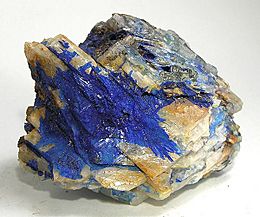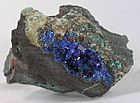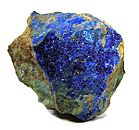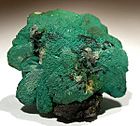Linarite facts for kids
Quick facts for kids Linarite |
|
|---|---|
 |
|
| General | |
| Category | Sulfate minerals |
| Formula (repeating unit) |
PbCu[(OH)2|SO4] |
| Strunz classification | 7.BC.65 |
| Crystal symmetry | P21/m |
| Unit cell | a = 9.701(2), b = 5.65 c = 4.69 [Å]; β = 102.65°; Z = 2 |
| Identification | |
| Color | Deep azure blue |
| Crystal habit | Crystals elongated and tabular; in crusts and aggregates |
| Crystal system | Monoclinic |
| Twinning | Common on {100}, also on {001} |
| Cleavage | Perfect on {100}, imperfect on {001} |
| Fracture | Conchoidal |
| Mohs scale hardness | 2.5 |
| Luster | Sub-adamantine, vitreous |
| Streak | Pale blue |
| Diaphaneity | Transparent, translucent |
| Specific gravity | 5.3 - 5.5 |
| Optical properties | Biaxial (-) |
| Refractive index | nα = 1.809 nβ = 1.838 nγ = 1.859 |
| Birefringence | δ = 0.050 |
| Pleochroism | X = pale blue; Y = blue; Z = Prussian blue |
| 2V angle | Measured: 80° |
Linarite is a beautiful and somewhat rare mineral. It is famous among mineral collectors for its amazing, bright blue color.
This mineral forms when other minerals like galena (a lead sulfide) and chalcopyrite (a copper sulfide) break down. This process is called oxidation, which is like rusting. Linarite is made of copper, lead, sulfate, and hydroxide. Its chemical formula is PbCuSO4(OH)2.
Linarite crystals often look like long, flat shapes or irregular clumps. It can sometimes be mistaken for another blue mineral called azurite. However, you can tell them apart because linarite does not fizz or react with weak hydrochloric acid, but azurite does. Linarite is also quite soft, with a Mohs hardness of 2.5. This means you could scratch it with a fingernail. It is also quite heavy for its size, with a specific gravity (density) of 5.3 to 5.5.
Discovery and Name
Linarite was first found and identified in 1822. It got its name from the Linares Plateau in Spain, where it was discovered.
Where Linarite is Found
You can often find linarite growing alongside other interesting minerals. These include brochantite, anglesite, caledonite, leadhillite, cerussite, malachite, and hemimorphite.
Image gallery
-
Linarite with malachite, Blanchard Mine, Hansonburg District, Socorro County, New Mexico USA (Size: 1.1 x 0.8 x 0.4 cm)
-
Linarite with caledonite, from Baker, El Dorado County, California USA (Size 5.4 x 5.2 x 3.2 cm)
See also
 In Spanish: Linarita para niños
In Spanish: Linarita para niños





